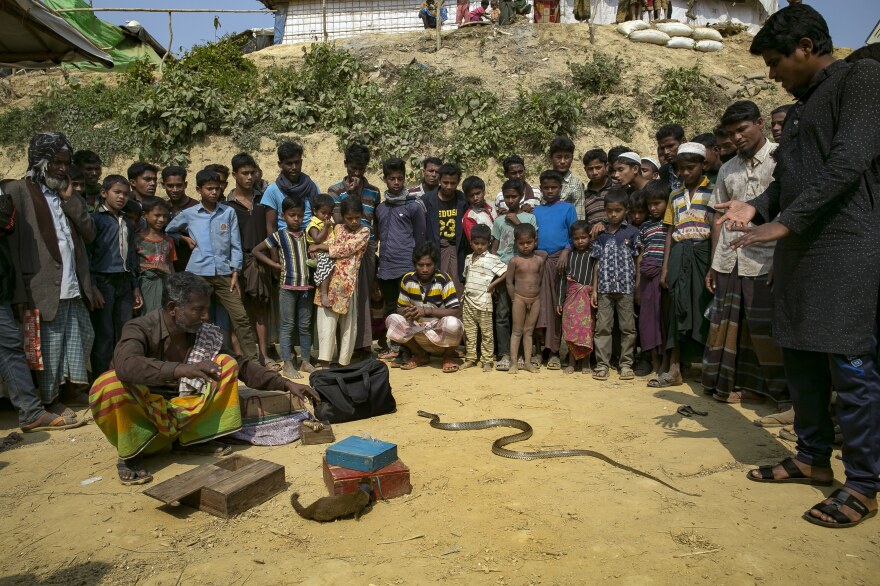In late January, NPR global health correspondent Jason Beaubien went to the Rohingya refugee camps in Bangladesh for a series of radio and web reports. It was the week that a plan to send the refugees back to Myanmar was supposed to start. But that program was put on hold because of logistics.
We interviewed Beaubien about his trip.

Did you meet anyone in the camps — refugees, aid workers — who thought repatriation is a good idea?
No one in the camps was arguing that sending the Rohingya back, at least right now, was a good idea. And not a single refugee I talked to said they'd be willing to voluntarily go back. You have to remember that they just fled Myanmar a few months ago and more Rohingya continue to arrive in Bangladesh every day.
It's hard to imagine that a city of nearly a million could just come into being. What was it like seeing the world's largest refugee camp and its sister camps?
So to be clear, these refugee camps didn't spring from nothing. There have been Rohingya living in camps in that part of Bangladesh since the 1990s. Those earlier refugees fled earlier waves of violence. But this latest wave was called "unprecedented" by the U.N. in terms of the number of people that arrived and how quickly they descended on Bangladesh. And you really see the effects of that in the camps. Shelter are not laid out in any grid, they're just all over the place. There aren't roads, just footpaths that lead into the dense parts of the camp. People have built shelters on incredibly steep hillsides without really any planning. And in terms of the number of refugees so many people arrived that what were three camps now are all just one big expanse of shelters.

So Kutupalong is now the largest refugee camp in the world with officially 547,000 people, but there's no boundary between Kutupalong and the Balukhali camp. It's just shelter after shelter. Then Balukhali flows in to Thangkhali. It's pretty amazing.
The U.N. has used the harshest language — "ethnic cleansing" — to characterize the flight of the Rohingya. Do they use similar language?
They definitely say that it was the soldiers and the military that were attacking them. The refugees I met didn't talk about it as a big, broad campaign against the Rohingya. They just said that soldiers were attacking their village, torturing men, raping women and they had to leave.
What makes the Rohingya refugee crisis different from other refugee crises?
One key difference is that the Rohingya are a stateless people. Myanmar essentially stripped them of citizenship in the 1990s. So they don't have passports. If they were to try to get in to any refugee resettlement program, it's more complicated because they don't have an official country of origin. Most lack any kind of identification or official documents that would be needed to process them for resettlement. It's not that it's impossible for them, but it's more complicated.
You've quoted and profiled a few of the refugees in your series? What voices are memorable from the refugee community?
The emotions of refugees really run the gamut. There are some young men who are very angry. I met one guy who described how the Myanmar soldiers beat him to the point where they thought he was dead and threw him in a ditch. But he wasn't dead. He showed me how they'd knocked his front teeth in.
One woman talked longingly about the farm and the cattle she had to leave behind. What struck me the most about her was that her main desire seemed to be a simple life. She just wanted to grow her crops and tend her livestock --something she can't do in the camp and might not be able to return to for years to come.
Other people seemed happy just to be in a place where they're safe.


Do the Rohingya feel like they're in Bangladesh for the long haul?
Yes, both the refugees and the aid groups working with them are clearly settling in for the long haul.
At first people built toilets that were just a hole in the ground with a sheet of plastic propped up around it for some privacy. Now they're building brick outhouses.
Schools are being set up. Deep wells are being dug. These people aren't going anywhere any time soon.

What did you hear from Bangladeshi citizens about this situation?
There were protests by local Bengalis while I was there. They were frustrated that the refugees are getting food rations every month and free health care. The locals also were complaining that the arrival of the refugees has driven up the price of food in the local markets, yet the jobs with the aid groups are going to people from the capital Dhaka or Westerners.
Several local Bengalis told me the refugees should get sent back to Myanmar. So politically having nearly a million Rohingya in camps is a headache for the Bangladesh government. That could become more and more of a problem the longer this crisis continues.

It seems like a dismal way to live. How do people cope?
It's only been a couple months that they've been there, for a lot of people. But mosques have sprung up in tents, some of the kids are flying kites, there are places where they play soccer. There's a game that's very popular — it's like volleyball but you can't use your hands, just kicking the ball over a net. We even came across one Bengali traveling salesman who attracted a big crowd with a snake-and-weasel show.
Copyright 2023 NPR. To see more, visit https://www.npr.org.




